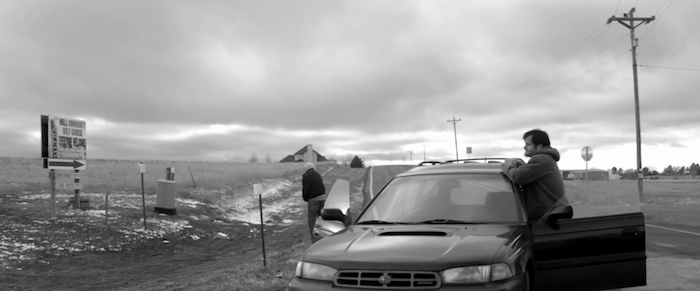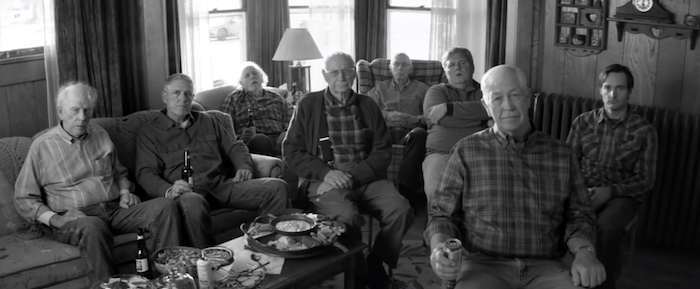Now you see it–now you don’t.
Much of the magic of Alexander Payne’s film Nebraska, which garnered 6 Film Independent Spirit Award nominations this week, consists of what is omitted from the camera’s view. Nebraska is the story of David Grant (Will Forte) who takes his dad, Woody, played by Bruce Dern, on a road trip from Billings, Montana to Lincoln, Nebraska, to claim what the old man thinks is a million dollar prize in a magazine sweepstakes. The screenplay was written by Bob Nelson more than a decade ago, during another of our country’s economic downturns, and because it took so long to get made, as is the case with so many good films, it is even more timely now, during our still-lingering Great Recession.
What are the important details, large and small, you don’t see in Nebraska? Here are 9 of them.
1. Color. It’s rare for a studio movie to be made in black and white, especially because it reduces the international sales potential. But credit the changing distribution landscape (a black and white film won’t turn off Netflix viewers, the way it would the broadcast TV audience), director Alexander Payne’s clout, and producers Albert Berger and Ron Yerxa’s tenacity. Of course, Paramount cut Payne’s budget by nearly half when he insisted on shooting in black and white.
Black and white images from America’s former Dustbowl recall Dorthea Lange’s famous depression-era photographs. Like Lange, Nebraska’s cinematographer Phedon Papamichael also shot on real Kodak film.
2. Movie stars. Paramount had also insisted on much bigger names in the cast, suggesting actors like Jack Nicholson. But that would have diminished the ensemble texture of the film. Bruce Dern, Will Forte and June Squibb may not be stars, but they are fine actors who are perfectly cast. We can also predict their stars will rise coming off this movie.

3. Boring skies. In the gorgeous gray-scale of the upper half of the frame, cloud, sun and sky combine in expressive detail to convey emotional aspects of big scenes. Credit the visual effects team for sky painting and seamless compositing.
4. Cell phones. Despite the fact that Will Forte’s character is clearly communicating with various family members during the road trip, we never see him pull out his cell. It’s just one more detail that roots the film in a somewhat mythical American landscape.
5. Chain restaurants. If you have driven across America lately, you know that small family diners have been replaced with Denny’s and Sonic Burgers; in most small towns, chain fast-food is the only option. In Nebraska, however, there’s not a Denny’s to be seen. Credit production designer J. Dennis Washington with care in finding locations, and choosing camera angles that omit big brands.
6. Craft beer. Not in these small American towns. They drink Old Milwaukee and Bud… even though Montana, where most of the film takes place, has the second highest number of craft breweries per capita in the nation.
7. No smoking in bars. Seems like people habitually light up while bellied up. Smoking in bars in Montana and Nebraska has been banned since 2009, but this detail doesn’t bother me, and even feels realistic for the characters.
8. New cars or houses. Everything needs a fresh coat of paint and a thorough dusting. The only new gear we see are some Bose speakers, in one of the opening scenes; Will Forte’s character is an audio equipment salesman, but, true to the ethos of the movie, he isn’t able to sell any new merchandise.

9. People standing in front of each other. Black and white imagery emphasizes visual composition more than color photography. Each shot is carefully designed, with balances of light and dark and exacting attention to where people are in relation to each other and their surroundings.
Read more: Bruce Dern and Will Forte talk with Cultural Weekly’s Sophia Stein.
Images from the Paramount Vantage film, ‘Nebraska.’
Adam Leipzig is the founder and CEO of MediaU, online career acceleration. MediaU opens the doors of access for content creation, filmmaking and television. Adam, Cultural Daily’s founder and publisher, has worked with more than 10,000 creatives in film, theatre, television, music, dance, poetry, literature, performance, photography, and design. He has been a producer, distributor or supervising executive on more than 30 films that have disrupted expectations, including A Plastic Ocean, March of the Penguins, Honey, I Shrunk the Kids, Dead Poets Society, Titus and A Plastic Ocean. His movies have won or been nominated for 10 Academy Awards, 11 BAFTA Awards, 2 Golden Globes, 2 Emmys, 2 Directors Guild Awards, 4 Sundance Awards and 4 Independent Spirit Awards. Adam teaches at UC Berkeley's Haas School of Business. Adam began his career in theatre; he was the first professional dramaturg in the United States outside of New York City, and he was one of the founders of the Los Angeles Theatre Center, where he produced more than 300 plays, music, dance, and other events. Adam is CEO of Entertainment Media Partners, a company that navigates creative entrepreneurs through the Hollywood system and beyond, and a keynote speaker. Adam is the former president of National Geographic Films and senior Walt Disney Studios executive. He has also served in senior capacities at CreativeFuture, a non-profit organization that advocates for the creative community. Adam is is the author of ‘Inside Track for Independent Filmmakers ’ and co-author of the all-in-one resource for college students and emerging filmmakers 'Filmmaking in Action: Your Guide to the Skills and Craft' (Macmillan). (Photo by Jordan Ancel)
